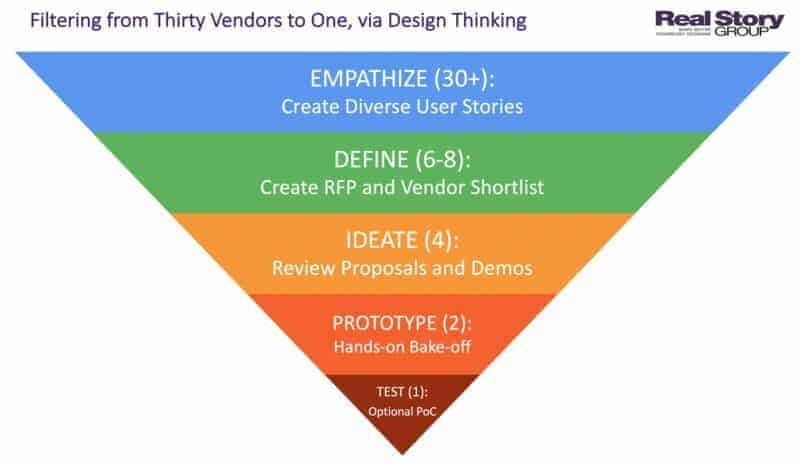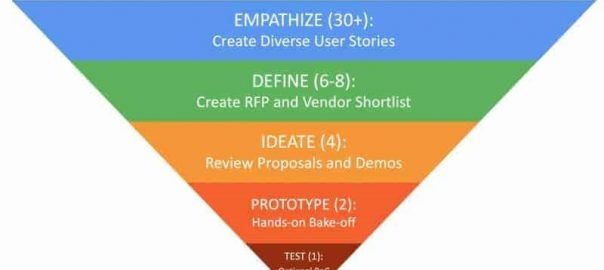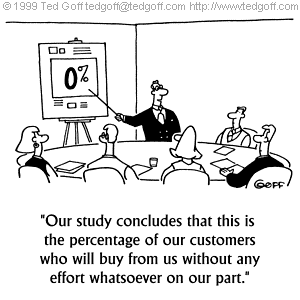Selecting better technology really means selecting better-fitting technology. Here’s how to do just that.
Industry surveys over multiple decades have repeatedly shown that more than half of technology projects fail to meet their objectives — or just fail outright. My discussions with martech customers suggest their success rates are no better.
There are many reasons for this, but in my experience, most technology problems originate in the critical early stages of an initiative. Once the boat gets headed in a particular direction, it can be hard to steer it back on course.
Choosing the right vendor and technology for your marketing initiatives is one of the most critical decisions you can make in those early stages. The wrong choice won’t necessarily doom a project, but it can make success much more difficult to achieve.
In the end, selecting technology better means selecting better-fitting technology. Here’s a look at 10 steps for doing just that.
1. Build the right team
Make sure to put together a team in the first place! Too many technology decisions still get made by a single person or department, which leads to a host of problems down the road. For example, I’ve seen marketing teams select tools that couldn’t integrate with the rest of the stack, and IT teams select platforms with prohibitively bad usability for marketers.
An interdisciplinary team of marketing and technical stakeholders is the best way to go. Just make sure the team is chaired by a business leader.
2. Define business success
You’re going somewhere with this new marketing technology. Where? You’d be surprised how many times an enterprise can’t answer that question. Instead, project leaders tend to articulate goals like “We need to replace our outdated marketing automation platform.”
Okay — that’s probably true. But what are you actually trying to accomplish from a business perspective? Do you want to empower more people internally to send messages to speed your processes and broaden your reach? Integrate omnichannel analytics to create better engagement with your existing customer base? Save money by escaping from an overly expensive solution? Those are different goals that could take you to different vendors.
Every selection process will confront you with potentially difficult trade-offs. Clearly articulated business goals provide a consistent touchstone throughout so you can make the right decisions along the way. Business goals as selection criteria also protect you when big martech vendors start bullying your executives.
3. Develop interactive requirements
Most tech selection requirements suck. But they don’t have to.
The first thing to do is close Excel and open Word. Avoid long checklists of requirements and instead tell digital stories. Here you can go back to your familiar marketing playbook of user-centered design (UCD) methodologies, emphasizing use cases, stories or top tasks — it doesn’t matter what you call them. Just do it. (Here’s an example.)
That way, when vendors pursue an agile competition that includes demos, prototypes and training, the experience becomes interactive (because you’re getting hands-on) and real (because you’re telling your unique stories).
4. Get the right shortlist of vendor options
Getting the right shortlist is critical. Too many enterprises waste time evaluating tools that are not good fits.
Don’t use single-snapshot views of a marketplace as a way to determine who should be on your list. Instead, find potential solutions that were fundamentally built to satisfy your most important use cases. In particular it’s time for quadrants to get “real.”
5. Draft a real RFP
Enterprises get anxious about crafting requests for proposals (RFPs), and with good reason: Developing an RFP can be a nerve-wracking endeavor. The selection team sometimes reacts by overdoing it — putting together long checklists of requirements and placing vague demands on bidders.
You can do this differently. RFPs should be human-friendly, human-scale and human-oriented. Get rid of buzzwords and share the stories you developed in Step 3. Yes, you need to include technical and architectural requirements, but even those can be presented as asking more about “how” and less about “what.” If you invite an intelligent conversation, you’ll get much better proposals.
6. Remember: Seeing is (almost) believing
But you shouldn’t put too much weight on written proposal responses to RFPs, because interactive technology will always look different on the screen than it did on paper.
The demo phase is key, because that is where you can really start to discriminate among competing offerings.
Just don’t make the common mistake of letting vendors demonstrate their wares in unstructured ways. Set up a tight demo process where competing bidders show how their systems will work in your scenarios. Likewise, when you’re reviewing integration or other technical requirements, press the bidders to show you live examples with code that is actually running, rather than just showing you diagrams or making vague assurances.
7. But don’t forget that doing is better
Seeing is good; doing is better. Always schedule a bake-off among at least two finalists where the members of your diverse team can get hands-on with the competing systems. This takes effort on all parts — not least because it requires some user training.
This will also likely cost you a modest sum of money, but the payoff is oh so worth it. Test-driving a system with your own scenarios and data gives the best indication of whether the technology — and the vendor — is a good fit. Critically, it also teaches you firsthand about all the changes you may need to make internally to fully exploit the new system.

Five stages of design thinking represented as steps for vetting a martech platform, with the number of prospective vendors in parentheses. Source: Real Story Group
8. Lose the formulas
During this process, you’re going to make “down-select” decisions — essentially voting some vendors off the island. What is the best way to do that? There are many legitimate ways to make decisions: voting, consensus, leadership fiat, and so on. When working with clients, I try to get to a consensus, though that’s not always possible.
There’s one approach you should avoid: mathematical formulas, where team members score the competing offerings and you apply weighting percentages to come up with overall rankings. Such spreadsheet-based approaches offer the chimera of scientific validity, but in practice, they almost never represent the real judgments of the team. What really happens? People retrofit their scores to reflect their own intuitive rankings.
Instead, take a no-B.S. approach of talking openly during wrap-up meetings and inviting members to rank-order and justify their choices, then work to get agreement on which vendors to push through to the next round. The good news is that if you have followed an adaptive, empirical approach as described above, the differences among vendors typically come into very clear relief.
9. Negotiate early and often
Most customers don’t start to negotiate fees and terms until they have chosen a vendor. That approach disempowers you in several respects. First, the loss of competition erodes your bargaining power. Then time pressures work against you, as pressure builds to start deploying the platforml you’ve chosen.
Instead, you should start negotiating when you start receiving the first responses to your RFP. You should insist on comprehensive price proposals and draft agreements up front. Start to whittle away excess fees, push back on weak service-level agreements, and challenge any unfriendly terms. And make it clear that responding to your concerns is a condition for getting to the demo round — and for making it from the demo to the bake-off. And after the bake-off, engage in further negotiations before announcing the winner.
Your mantra at every step should be, “Price and terms are part of our decision process.”
Vendors will push back. They are experts at this game. You likely are not an expert, but you’re the buyer, so you should set the process and you shouldn’t worry about hurt feelings. Everything gets reset once you sign the contract, so get the best contract you can.
Read more from Jarrod Gingras of The Real Story Group
10. Pilot quickly
The best way to confirm that you made the right choice, and the best way to understand how things will be different with the new technology, is to launch a pilot test in a live environment as soon as possible. While the bake-off was not designed to create a production instance, in the pilot you want something you can actually roll out to customers or your workplace peers.
So pick a good pilot — not something too complicated, but still a representation of the value you want out of the platform. You may want to launch the pilot in a single country or specific marketing use case. However you set up the pilot, proactively capture lessons learned before moving on to a broader set of rollouts.
The end goal
In the end, selecting technology better will lead you to selecting better-fitting technology. A new platform itself is no guarantee of martech success, but choosing the right tools sets you up to succeed at all the other changes your team needs to carry out.
Real Story on MarTech is presented through a partnership between MarTech and Real Story Group, a vendor-agnostic research and advisory organization that helps organizations make purchasing decisions on marketing technology applications and digital workplace tools.
The post The Real Story on MarTech: 10 steps to making better vendor selection choices appeared first on MarTech.
(43)








